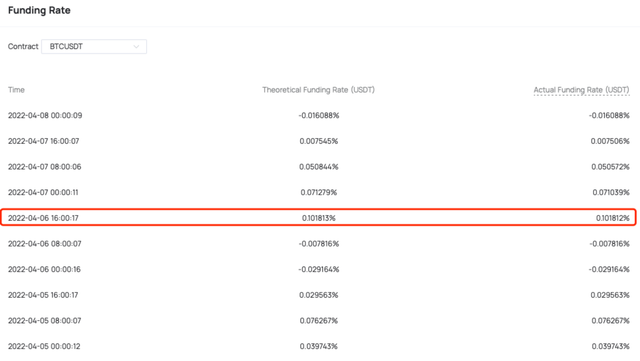Futures, which have no expiry date, are in a class by themselves in the crypto exchange. Since the delivery contract will be delivered on a regular basis, despite a large spread between the contract price and the spot price, the price will go back to the spot level eventually.
.png)
With no delivery date, futures can be held by users for good. The lack of a correction mechanism may lead to an everlasting or even growing deviation between the contract price and the spot price, which is a price decoupling as we know. To this end, the futures have introduced a funding fee mechanism to maintain the consistency between the contract price and the spot price and make the former anchored to the latter.
The Funding Fee is settled every 8 hours. When the Funding Rate is positive, the Funding Fee is paid by long traders to short traders; when the Funding Rate is negative, the Funding Fee is paid by short traders to long traders. The Funding Fee will be charged according to the Funding Rate calculated one minute before the last timestamp. For example, when settled at 16:00, the Funding Fee will be charged in accordance with the Funding Rate at 07:59. The Funding Fee is not charged by the platform but paid by/to traders.
The Funding Fee is calculated as below (Take CoinEx for example. The Funding Fee may be subject to different calculation methods in other exchanges):
Funding Fee = Position Value * Funding Rate
Funding Rate = Clamp (MA (((Impact Bid Price + Impact Mark Price) / 2-Spot Price) / Spot Price — Interest), a, b)
*Currently, Interest is 0, a=-0.375%, and b=0.375%.
Impact Bid Price = Average Price of “Impact Margin Amount” for Bidders, Impact Mark Price = Average Price of the “Impact Margin Amount” for Sellers.
Clamp(A, B, C): When A is within the range of B and C, take A; otherwise, take B as the lower limit and C as the upper limit (B < C).
It is thus clear that a positive Funding Rate reveals a bullish market, while a negative Funding Rate suggests a bearish market.
So what profit-making opportunities could the Funding Rate offer? First of all, the value of the Funding Rate can function as an indicator of the market sentiment. Yet still, it’s just for reference. After all, a single indicator cannot build up a picture of the general market.
Secondly, arbitrageurs with a relatively large amount of capital can arbitrage using the Funding Rate of futures. Calculated from the data of the previous time period, the Funding Rate is inevitably subject to certain delay, and therefore can be roughly estimated based on the forecast.

When the Funding Rate is on the high side, traders can buy the spot contract of 1 BTC while shorting futures of 1 BTC. In this case, no matter how the BTC price moves, the spot profits can hedge the loss of the futures, and traders can earn the Funding Fees paid by long traders to short sellers. For example, if the current Funding Rate reaches 0.1%, with the BTC price of 41,000 USDT at this moment, there will be a profit of 41 USDT.
The Funding Rate in the next time period matters too. If it plummets, traders can close the position to gain profits. If a positive Funding Rate becomes negative, then traders need to decide whether to go the other way round for arbitrage.
Futures traders must have a keen eye for market data, of which the Funding Rate is a very important part. Only well-informed traders can seize the first-mover advantage and grasp the market sentiment to rake in profits they deserve.